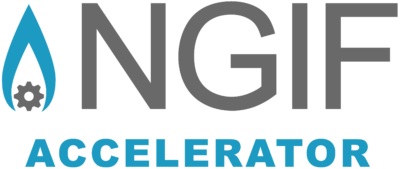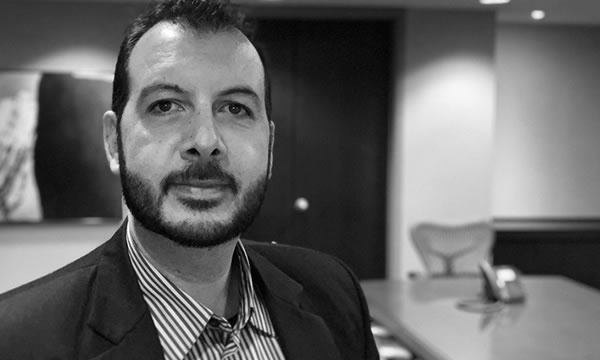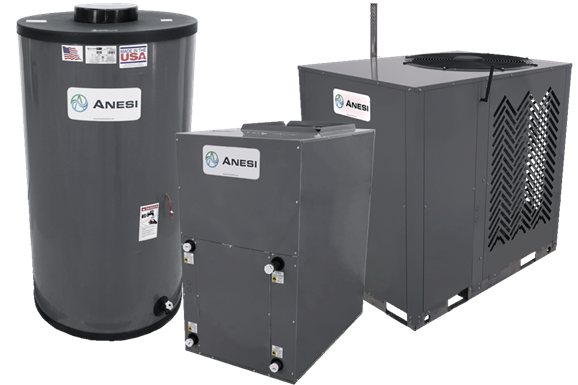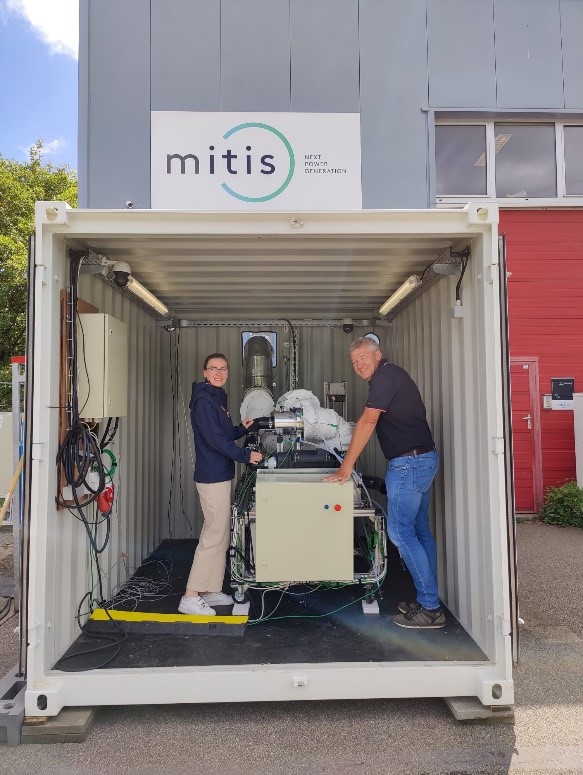
Anesi is developing a fully integrated "single-box" solution to replace furnaces, boilers, air-conditioners, and hot water heaters with a best-in-class energy efficient and lowest cost "hybrid" unit. The system will target a heating AFUE of 140% and a cooling SEER 16 which correspond to a 45% and 12% increase in performance compared to conventional heating and cooling technologies. The integrated "Hybrid" system will be ultimately designed to provide year-round space conditioning as a single installed unit and replace the standard two system installation furnace and electric air-conditioner, plus domestic hot water.
Stone Mountain Technologies (SMTI) will join forces with Canadian HVAC manufacturer Napoleon to finalize technical designs and the business case for the market entry of a Thermally Driven Heat Pump (TDHP). TDHPs can replace furnaces in residential buildings, and in "combi" mode, they also provide domestic hot water.


The project provides an opportunity to showcase the full implementation of Harvest’s POWER system across three Pizza Pizza locations within the Greater Toronto and Hamilton Area. The implementation will allow Harvest’s building modeling tools to be fully trained and to further establish the company’s ability to deliver a complete product at the completion of the demonstration project.


This project will demonstrate the use of Hydrogen Reduction for the conversion of Automobile Shredder Residue (ASR) and sewage sludge by running a large-scale pilot unit capable of processing up to 10kg of ASR and sewage sludge. The demonstration runs will be performed to convert the material, determine the quality/quantity of gas produced, and evaluate the residual material composition. The results from the demonstration runs will be evaluated to adjust the operating conditions of the unit to produce the highest quantity and quality of product gas based on methane content.


This project is the first phase of a three-path roadmap towards commercialization of a new technology for renewable natural gas synthesis from waste carbon dioxide. This project will advance electrocatalytic technology and demonstrate a prototype system that converts CO2 into methane at metrics that enable cost competitive RNG production: as low as $10/GJ.


Hiller Truck will be installing 1 CNG dual fuel system on an "Off Road" C15L CAT engine running an air compressor and then a 2nd CNG dual fuel system on a "On Road" 2018 F/liner with DD15 Detroit. Hiller Trucker will then be optimizing combustion by removing up to 60% diesel, and replacing it with clean burning fuel, natural gas, and or renewable natural gas thus reducing emissions by up to 90% when using Renewable Natural Gas (RNG)


ThermoLift’s Thermal Compression Heat Pump (TCHP) combines heating, cooling, and domestic hot water delivery into a single appliance utilizing the proven Hofbauer Cycle. This innovative cycle improves system efficiency and results in a significant reduction in building energy costs and greenhouse gas emissions.


With this project, Carbon Upcycling Technologies (CUT) will further the evaluation of the Carbon Capture Membrane as part of the company’s operations at the Alberta Carbon Conversion Technology Centre. Throughout the course of the project, CUT will be designing and commissioning a unit, and evaluating the effectiveness of the capture membrane in an operational setting by removing the CO2 that is present in a natural gas power plant’s flue emission.


This project will demonstrate the capacity and performance characteristics of manure only recipes in currently available digester equipment (Dairy/Poultry/Hog) to reduce complexity and increase reliability of on farm digesters.


Production of Clean Hydrogen from Natural Gas


Innovative Fuel Systems (IFS) has developed a dual fuel technology that allows heavy duty truck engines to displace up to 50% of diesel fuel with cleaner burning natural gas. The proprietary, and patent pending, technology allows customers to significantly and impactfully save on fuel costs (up to 30%) and reduce greenhouse gas (GHG) emission by 9%.
The project involves the commercial validation of IFS’ dual fuel technology. This will entail utilizing a large Alberta-based heavy-duty fleet to test and validate the technology in daily operations for a period of 22 months.


Enersion will co-develop and demonstrate a green and cost saving quad-generation that produces Electricity, Cooling, Heating and CO2 in one integrated package for a fish farm in Nobleford, Alberta. The cornerstone of this system integration is the Enersion new green cooling technology that allows all-year-around system operation to use natural gas to provide the essential needs of the farm.
Enersion had to develop and demonstrate an adsorption-based chiller that ranges from 1 tonne to more than 10 tonnes of cooling power.


Through this project, Hydrogen Optimized aims to demonstrate its scalable, novel and propriety RuggedCell™ water electrolyser system and its ability to be directly coupled to solar panels, wind turbines and unstable grid connections to produce hydrogen and oxygen.


The project objective is to add the process steps to convert raw syngas being produced at an existing commercial-scale pyrolysis field demonstration system via gas treatment, methanation and upgrading into renewable natural gas. The system processes 500 kg/hr of wood waste and will generate approximately 50 kg/hr of renewable natural gas. With the goal of rapid deployment of a field demonstration, the project will run in a campaign mode, where different feedstocks and operating conditions are run continuously. The resultant RNG will be tested to ensure it is of pipeline quality and will be combusted in an enclosed flare within the system boundary scope.


The project will demonstrate the SmartWatt Boiler (SWB) economic and carbon-reduction viability and the efficacy of the Heat-as-a-Service model in accelerating market introduction and achieving high social acceptance.


This project will demonstrate improved fuel operating efficiency of boilers and other fired equipment from the industry standard rate of 84% and bring it up to 93%-97% fuel efficiency. The energy efficiency gain will also greatly reduce the CO2 emissions from fired equipment, in addition to scrubbing CO2 from the exhaust gas.


The project will commercially demonstrate a low-cost, automatic methane imaging solution for continuous detection and quantification of emissions at 40 natural gas upstream sites, and sites with tanks.


The objectives of the project are to design, assemble/package and test a remote power unit based on a production-ready Etalim thermoacoustic (TAC) genset plus to-be-built or sourced balance of plant components in an enclosure suitable for remote power use. The project boundary is the production of 24V electricity. The project includes an 8-month field test with the demonstration system running continuously without failure or significant degradation.


The project is designed to prove the RXGC’s performance (technical and economic) as well as its energy efficiency, reliability and durability as compared to incumbent alternatives. The project will also allow for the collection and analysis of data to quantify operation and maintenance costs and establish operation and control parameters.


The objective of the project is to conduct a field pilot of GHGSat’s satellite-aircraft hybrid system in the BC Montney shale play. The scope includes planning and execution of the field pilot for the satellite-aircraft hybrid system including scale-up of GHGSat’s analytics suite in the BC Montney region, perform four aircraft surveys using GHGSat-AV and measurements using GHGSat-C1, GHGSat-C2 and GHGSat-D and analyze and report on results.


The project will develop and conduct field trials and pilot demonstration of Luxmux's Accurate Remote Monitoring System (ARMS) for Methane and Carbon Dioxide measurements. The results of Luxmux’s air dispersion model will be bench-marked against other air dispersion models for comparison purposes. These representative area emission measurement results will help Alberta’s Oil & Gas Industry compete with an ever-changing green marketplace by reporting out accurate and favorable results from emissions measurements.


This project will demonstrate the economic feasibility and operational effectiveness of the RadMax Expander-Generator-Compressor (RXGC) to reducing pneumatic controller and pump methane emissions at the wellhead and at gas pipeline pressure letdown stations. The RXGC recaptures some of the energy otherwise lost by incumbent technologies and provides a reliable and inexpensive source of electricity and/or compressed air to power upgraded existing pneumatic devices. Produced electricity can also be used to power other electrical monitoring, security, lighting and communication devices at the site.


The project will demonstrate Ekona’s novel Pulse Methane Pyrolysis (PMP) process for low-cost clean hydrogen production with a solid carbon by-product. The project will additionally demonstrate a Direct Carbon Fuel Cell (DCFC), which when added to the PMP, creates a tri-generation pyrolysis (TGP) system.
Ekona had to show a proof-of-concept for the Pulse Methane Pyrolysis (PMP) reactor and a Direct Carbon Fuel Cell to validate the technology to TRL3 and inform subsequent prototype, brass-board, and field trial development.


The goal of the project is to demonstrate the ability of the Ionada Pilot system, located in Alberta and later to be located at OTSG in Saskatchewan, to remove and capture CO2 from the flue gas related to the combustion of LNG at the station, resulting in reduced CO2 being emitted into the atmosphere from the station operation.


The G4 Power to Gas (P2G) showed the use of G4 PyroCatalytic Hydrogenation (PCH) technology to utilize renewable grid power and forestry waste to produce renewable natural gas (RNG). The project objectives included the design and build of G4 P2G equipment, RNG production using steady-state grid power, and RNG production using intermittent grid power.


CHAR had to demonstrate the scale-up of the SulfaCHAR production system with the objective of continually producing 1-tonne per day of SulfaCHAR with a capacity of at least 30% by weight for H2S and a surface area of at least 250 m2/g. SulfaCHAR works by removing the toxic H2S from biogas in the same way that a Brita water-filter removes contaminants from tap water.


The Effect Home Builders office space – a 1940s era two-story home – was retrofitted using clean technologies and natural gas together to create a net-zero office space disconnected from the electrical grid, with lower costs and lower GHG emissions.


The i2 Hybrid Smart Furnace (HSF) has a unique patented system that uses natural gas to generate both heat and electricity for use in the home. The self-powered i2 HSF is intended to be installed as a replacement for traditional residential natural gas furnaces with no extra connections.


The project focuses on the development, design verification, safety certification, and vehicle integration and testing of a novel new conformable Compressed Natural Gas (CNG) tank technology that replaces the bulky CNG cylinders typically associated with natural gas vehicles. The initial target application is pickup trucks.


Saltworks’ AirBreather Pilot uses excess heat from natural gas production to treat produced water on-site. The project tested their evaporation system on saline (salty) produced water samples, collected from natural gas operations in the BC Montney. Produced water is water that flows to the surface with gas and oil during the production process - AirBreather converts it to clean water or water vapour.


Solistra Corporation provides a green chemical process for converting the greenhouse gases - carbon dioxide (CO2) and methane (CH4) - simultaneously into synthesis gas, using solar-activated nanomaterials known as “photocatalysts”. Their core technology is a combination of low-cost photocatalysts, made of precious metal-free nanomaterials that are activated by light to drive the desired chemical reaction. Their scalable photoreactors, the vessels in which the photocatalysts resides, convert the gases into products



Vice President, Engineering, Birchcliff Energy Ltd.

Vice President, Technology and Innovation, Canadian Natural Resources Limited

SVP, Strategy & Sustainability, Cutbank Dawson Gas Resources & Diamond Gas Management Canada

President & Chief Executive Officer, Perpetual Energy Inc.

Vice President, Production, PETRONAS Energy Canada Ltd.

Commercial Partnership Manager/GameChanger, Shell Global Solutions Canada

Chief Operating Officer, Tourmaline Oil Corporation

Vice President, Operations, ARC Resources


ThermoLift is leveraging technology based on the Hofbauer Cycle to develop a natural gas heat pump that provides heating, air-conditioning and water heating from a single appliance. ThermoLift’s technology has the potential to revolutionize the HVAC space by providing a significant reduction in building costs, as well as associated reductions in greenhouse gas emissions.


Ionomr Innovations is a developer of ion-exchange membranes and polymer product solutions. Ion-exchange membranes are critical components to many electrochemical applications including hydrogen production, zero-emissions vehicles, and synthetic fuel production from CO2 capture and conversion processes.


Ionada develops, manufactures, and markets exhaust gas cleaning systems for Carbon Capture, Utilization, and Storage solutions. The Company is the first to market with a patented membrane contactor decarbonization system for small to mid size carbon emitters – less than 200,000 tons per year. Ionada’s containerized modular carbon capture system provides a compact and affordable solution for most industrial carbon emitters.


Ekona Power has developed a novel Pulse Methane Pyrolysis (“PMP”) platform that delivers a clean, low-cost, and scalable solution for industrial hydrogen production. Their proprietary technology uses the principles of pulse-combustion and high-speed gas dynamics to dissociate feedstock methane. Ekona’s PMP hydrogen production process generates up to 90% less CO2 compared to traditional Steam Methane Reforming.


Validere is a leading data and analytics Software-as-a-Service provider that is digitally transforming the oil and gas supply chain to be more sustainable and efficient. Validere is building the first universal data layer for oil and gas. This data layer aggregates all available customer provided data into a complete, accurate, and auditable repository that allows the Company’s customers to create a real-time digital fingerprint for each molecule that travels along the supply chain from producers to end users.


Galatea Technologies provides Software-as-a-Service for logistics optimization in the wastewater disposal process. Galatea’s Waste Coordinator software aggregates facility wait times, capacity, and disposal fees and uses advanced geospatial algorithms to calculate the optimal (and cheapest) waste disposal option.



Director, System Modernization, ATCO Gas and Pipelines.

Manager, Technology Development, Enbridge Gas Inc.

VP, Corporate Services and Technology, Fortis BC

Director, Business Development and Stakeholder Relations, Pacific Northern Gas

Executive Vice President, Customer Service Operations, SaskEnergy Inc.

Director, Engineering and Construction Services, APEX Utilities



Alberta Innovates – Director, Recovery Technologies

Alberta Innovates – Executive Director

Natural Resources Canada – Deputy Director

Natural Resources Canada – Science and Technology Advisory

NGIF – President and CEO

University of Calgary – Professor (Chem&PetrolEng), Director Global Research Initiative Energy, EnCana/Pet.Soc. Endowed Chair at UCalgary

Tourmaline – Director, Technology and Innovation



Tourmaline – Director, Technology and Innovation

Tourmaline – Innovation Engineer, EIT

Tourmaline – Innovation Engineer, EIT

Tourmaline – Innovation Engineer, EIT

University of Calgary – Professor (Chem&Petrol Eng), Director Global Research Initiative Energy, EnCana/Pet.Soc. Endowed Chair at UCalgary.

University of Calgary - ETC Lab Coordinator

Modern West Advisory – Vice President, Technology


Drilling rig engine generators provide up to 4 MW of electrical power to the rig; they are large fuel consumers and hence GHG emitters. Ensign has several types of engines and fuel type setups, including diesel, bi-fuel (diesel & natural gas), and natural gas hybrid (gas and battery power) systems. Five Ensign rigs are equipped with instrumentation for fuel measurement. The goal of field testing with ETC is to understand the fuel and energy efficiency of the various power systems across Tourmaline’s drilling operations.


LSI has been a leading service provider of aerial sensing data collection and processing for numerous industry sectors for over 20 years. They were selected to participate in the NGIF’s Emissions Testing Centre (ETC) program to conduct field testing of their thermal infrared hyperspectral imaging system, a technology that identifies and quantifies gas leaks. This is a fixed-wing mounted technology that was used to fly both the live gas facility and a secondary controlled release site, in both winter and summer conditions.


Qube is a leading provider of environmental surveillance technology focused on low-cost, continuous monitoring of GHG emissions. Qube was selected to participate in the NGIF Emissions Testing Centre (ETC) program, to validate and demonstrate their fixed sensor and continuous emissions monitoring technology. Qube perimeter sensors are installed at the ETC gas plant and the venting controlled release site.


AltoMaxx is a leading-edge drone service provider focused on developing integrated solutions within the natural gas industry. They were selected to participate in the NGIF’s Emissions Testing Centre (ETC) program to demonstrate and validate their drone-based methane sensors that detect and pinpoint leak locations along pipelines, well heads and natural gas facilities. AltoMaxx flew their drone at the ETC gas plant and at a secondary controlled release site, with the goal of developing data to quantify emissions.


Luxmux is an experienced manufacturer of emission monitoring systems focused on detecting and tracking emissions while making the data available and easily accessible. Luxmux is participating in the NGIF’s Emissions Testing Centre (ETC) program, to demonstrate and validate their ARMS Smartpole™, a multiple-gas detection system created to monitor emissions constantly.


Spartan is proposing to test Smart tank pressure control equipment to monitor and minimize emissions from liquid storage tanks. Pressure control equipment and tank venting instrumentation will be sized, selected, and tuned to work in conjunction with the vapour recovery system. The work done at ETC will focus on testing of pre-commercial tank vent flow meters, and testing of Spartan’s proposed integrated solutions for innovative control of tank thief hatches.


The Marathon KL8 is an instrument air and power unit. Powered by a new-to-industry industrial 5 kW engine, the KL8 can provide tscfm of dry instrument air at 100 psig along with 1.5 kW 24 VDC power for meters, plc’s, etc. At the ETC, the Marathon compressor has been installed in an operating gas well site facility. The main goal is proving run-time and equipment durability, mostly of the engine, on raw field-quality natural gas.


Packair Industries has developed a new air compressor that is compact and highly efficient. The design uses 10 pistons in a circle, each with its own valve system and can be driven by either AC or DC power. The compressor can deliver full pressure of up to 130 psig and up to 10 cfm. The compressor can be packaged in a small compact space as an air solution for remote Oil & Gas well sites to reduce methane emissions that run pneumatically driven devices. This solution is proposed as being cost-effective and requiring minimal downtime for installation. The ETC lab testing focused on demonstrating that the Packair compressor works, along with measuring the ability of the Packair compressor to deliver air at different rates and conditions, and the power requirements for these various configurations.


A solution that reduces emissions and complies with regulations is to collect and combust the waste gas emitted by well site pneumatic devices through an enclosed vapour combustor. The gas from the pneumatic instruments is collected into a main header outside of the well site separator building and sent to a low-pressure combustor for incineration. Enclosed vapour combustors are virtually maintenance-free and require few changes to existing infrastructure prior to commissioning. At the ETC, the scope of the project will involve the investigation of the destruction efficiencies during operational conditions to understand its effectiveness with turndown ratios. Manufacturer specifications state the destruction efficiency of the vapour combustor is greater than 99.9% and meets the requirements of AER Directive 60, however, in-field data is limited to validate the performance given the novelty of the solution.


Kuva is a leading methane monitoring technology provider committed to making emissions quantifiable and manageable. Kuva is participating in NGIF’s Emissions Testing Centre (ETC) program to conduct a field demonstration of their emissions-detecting cameras that uses short-wave infrared light to detect and monitor hydrocarbon gas emissions in real-time.


mCloud Corp. is a software/hardware company that is focused on tackling the Fugitive Gas dilemma using Software, Cloud Computing, and AI in conjunction with Ultrasonic Hardware. The goal is to detect gas in real-time and help drive action and correction sooner than traditional expensive methods. mCloud is working with the ETC lab to test their mobile ultrasonic sensor on variable emission rates and single vs. multiple source points, with and without the presence of external noise.


Drilling rig engine generators provide up to 4 MW of electrical power to the rig; they are large fuel consumers and hence GHG emitters. Precision Drilling has several types of engines and fuel type setups, including diesel, bi-fuel (diesel & natural gas), natural gas hybrid (gas and battery power), and zero fuel (electrical highline power) systems. Four Precision rigs are equipped with instrumentation for fuel and power measurement. The goal of field testing with ETC is to understand the fuel and energy efficiency of the various power systems across Tourmaline’s drilling operations.


Frac pumpers are large fuel consumers that emit large amounts of greenhouse gases into the atmosphere. Current fracturing equipment in Alberta is typically powered by diesel-based or bi-fuel (diesel & natural gas) bolt-on kit (Tier 2) engines. Trican’s Caterpillar Tier 4 Dynamic Gas Blending engine proposes to displace up to 85% of diesel with natural gas. The goal of field testing at ETC is to understand the performance of the Tier 4 Engines during operations in Canada. This includes, but is not limited to, diesel displacement performance during seasonal conditions, validation of the low emissions fracturing spread, and emissions performance compared to diesel and Tier 2 engines.


ARIX develops and operates robots for pipe corrosion detection and management for the oil and gas industry to reduce costs, enhance data, and improve safety.


Lelantos is a developer of miniaturized semiconductor gas sensors based in New York, NY. Lelantos novel gas sensing technology is targeted to high-value Internet-of-Things applications in environmental and air quality monitoring, threat detection, industrial safety, as well as medical diagnostics.


HOMY’s hybrid technology combines GAHP and Air Source Heat Pump (ASHP), maximising the potential of both technologies. Its smart control system monitors and controls energy consumption effectively, offering the potential to reduce energy consumption, and greenhouse gas emissions.
The expected outcomes of the project include the successful development and launch of the customized GAHP technology, improved energy efficiency and cost savings for homeowners, and increased adoption of the technology in the North American market.


Anodyne’s proprietary technology and first of a kind reactor harnesses enzymes for carbon utilization and turns harmful emissions into low carbon fuels and speciality chemicals. The project aims to develop protocols for producing four enzymes and their corresponding immobilization complexes, while also collecting operational data for enzyme endurance, current efficiencies, and voltages in an electrochemical cell. The objective of upscaling the electrochemical cell and investigating immobilization feasibility contributes to advancing enzymatic methanol conversion technology.


The project provides an opportunity for BKR Energy to develop its smart fuel-switching controllers to boost emissions reductions with cost effectiveness. The design will accelerate the efficiency and affordability of hybrid HVAC systems when switching between electricity and natural gas.


CarboNet applies advanced chemistry to industrial wastewater, reducing the need for chemicals, increasing water treatment performance, and boosting the world’s freshwater reserves.


Qube Technologies is a Calgary, AB-based hardware-enabled SaaS business helping primary industries reduce emissions through continuous monitoring. Qube’s solution utilizes a three-step approach to emissions management: detecting emissions (using Qube devices deployed in the field), measuring (inferring leak location, quantifying, and classification), and reducing (managing repairs and reducing emissions using Qube’s dashboard).


Carbonova’s revolutionary patent-protected process converts widely-available greenhouse gas feedstocks – such as methane and carbon dioxide – into a sustainable, relatively inexpensive, high quality solid carbon nanomaterials product. The carbon nanomaterials can then be used in multiple market applications, ranging from plastics to batteries and construction materials. Carbon nanomaterials have unique performance attributes, including low density, high mechanical strength, as well as electrical and heat properties, which contribute to improving the overall performance and reduce the carbon footprint of everyday products.

This disclaimer outlines the limitations of the environmental and emissions performance claims and metrics on this website. While NGIF Capital and NGIF Accelerator strive to ensure emissions reduction and performance claims are accurate and based on adequate and proper testing, they do not independently verify or endorse the accuracy of all third-party claims or metrics presented.
NGIF Capital and NGIF Accelerator disclaim any liability for the reliability or completeness of third-party environmental performance claims and metrics, emissions performance statements, representations, or claims made on this website. By engaging with this content, readers acknowledge that NGIF Capital and NGIF Accelerator are not responsible for any damages or claims resulting from reliance on these emissions performance claims. Visitors are encouraged to verify all claims independently before making decisions based on this website.

